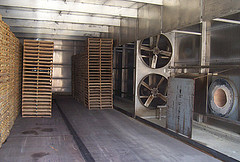
UNIVERSITY PARK – As invasive forest pests such as emerald ash borer and Asian long-horned beetle decimate forests they never should have seen, scientists are investigating ways to slow the introduction of new insects that may be just as devastating.
One collaborative project that involves wood-products, engineers and entomologists in Penn State’s College of Agricultural Sciences is showing promise. The primary goal of the research is to develop alternative and better ways to ensure that pests and pathogens don’t hitchhike in pallets and wood packaging used in international shipping.
The research could help the more than 170 countries that have agreed to comply with new shipping guidelines known as the International Standard of Phytosanitary Measures No. 15 — ISPM-15 — according to John Janowiak, professor of wood products engineering.
“Methods of killing pests and pathogens — known as phytosanitation measures — are required for all solid-wood packaging material, such as wooden-constructed shipping pallets, used for import/export commerce worldwide,” said Janowiak.
“These measures are mandated under the United Nations Food and Agriculture Organization’s International Plant Protection Committee,” he said. “The goal of ISPM-15 is to significantly reduce the risk of introduction of alien invasive insects and pathogens that can kill native urban and forest trees, destroying commercial forests and landscape trees.”
Existing control measures largely are limited to conventional heat treatment — which involves a long, slow process of convection heating of the wood material in huge ovens to 56 degrees Celsius for 30 minutes — or the use of methyl bromide. But the use of that chemical as a fumigant is challenged widely because it is classified as an ozone-depleting gas and has been banned in several countries.
“Our research includes a diverse array of experimental data collection and studies on how dielectic heating interacts with wood,” Janowiak said. “We are evaluating the efficacy of microwave and radio-frequency energy — using both batch and continuous processes — to rapidly sterilize solid-wood packaging materials. These treatments are designed to replace methyl bromide fumigation.”
The work on microwave processes has progressed to the point that a formal submission on the use of microwave energy under ISPM-15 has been recommended for approval to the Standards Committee of the International Plant Protection Convention, noted Kelli Hoover, professor of entomology.
“Assuming our submission passes country consultation, microwaves will be the first alternative treatment adopted under ISPM-15 since it was implemented almost 10 years ago,” she said. “We currently are tweaking the treatment schedule and guidelines for commercial implementation.
“But because radio frequency — also known as RF — has better penetration depth than microwaves, the team is currently focused on developing the efficacy data set and treatment schedule for submission of RF heating for adoption under ISPM-15.”
Janowiak predicted the research will expand to other forest-based commodities such as woody biomass, including pulp chips exported for either heating biofuel or fiber pulp recovery. “These products, over time, may have to comply with newer international regulatory policies to be certified pest free,” he said.
“These measures likely will be needed to further control the movements of highly destructive pests between trading-partner countries.”
While phytosanitary control across international boundaries is the primary objective of the research, the team also is analyzing the overall environmental and economic benefits of the competing technologies. Charles Ray, associate professor of wood products operations, is leading life-cycle analysis of the alternatives.
“Stopping the movement of pests and diseases can be done through a number of means,” he said. “However, each potential solution produces different impacts on climate change and sustainability measures, such as carbon dioxide emissions, aquatic ecotoxicity and use of nonrenewable energy, to name just a few.
“Our project is designed to ensure that the analysis presented to the international regulatory bodies includes an assessment of these impacts, as well as the relative cost of each.”
This comprehensive approach to the research has been noted by the international community. At a presentation of preliminary results in Lisbon, Portugal, last September, Hoover received encouragement from several delegates of other countries to continue the life-cycle impact assessment component of the project.
One leading delegate of the United Nations Food and Agriculture Organization even commented that the Penn State team’s approach may well turn out to be the model by which other regulatory research will be conducted in the future.
The Penn State research is funded by the USDA Methyl Bromide Transitions Program.
Jeff Mulhollem, Penn State University